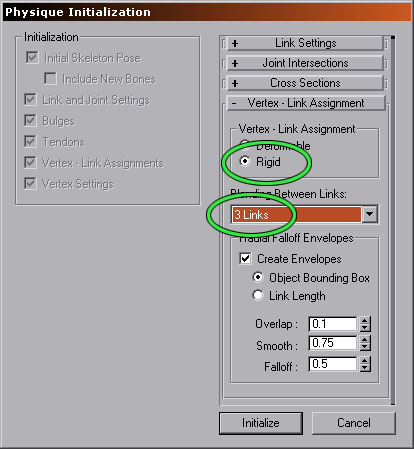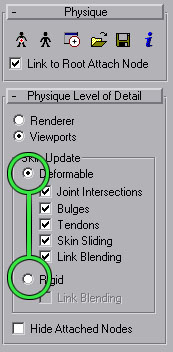|
LEASE
NOTE: this document is obsolete. Please consult the Unreal
Developer Network site for the latest documentation including
detailed tutorials and plugins.
Overview
Skeletal
animation gives your characters smoother movement than
was possible with vertex animation, but they must be designed
and prepared properly to get the desired results. Generally,
polygon counts can increase, because memory usage does not
balloon as it does with vertex animations, and rendering power
becomes the new bottleneck. The difficult part is that the
artists no longer have frame by frame, vertex by vertex control
of their animations. Each vertex can only be animated by the
bones around it, with fewer being better. It is recommended that
each vertex has 3 or fewer influences, but more can be used if
really needed. No bulges, tendons, or other special Physique
tools may be used. This is necessary so that meshes will deform
in Max exactly as they will in the game engine.
Optimizing
your Mesh
Any mesh can
benefit from being tweaked for use in game, no matter how good
it looks in Max. The Unreal Engine uses vertex lighting for
meshes, which means that light and dark areas are applied at
actual vertices, with areas in between calculated as an average.
Therefore, the more vertices there are the smoother the lighting
will appear. If you have the polygons to spare, make sure you
have a minimum number of 'long' edges. Even on a robotic
character, a thigh section that stretches from the hip to the
knee will look better if there are a few segments in it.
Skeletal
animation is not as kind as most would like on areas such as
shoulders and elbows. This is because the influences of the
bones on the vertices are linear, not spline-based like
Physique's Deformable mode. A shoulder lifted straight above the
head is prone to pinching, unless designed particularly well. A
workaround is to segment the arms from the body if appropriate,
as in the case of robots, knights in armor, or even characters
in vests or clearly segmented clothing. Another possible
solution is to add an extra 'helper' bone to your skeleton that
can be animated to make the skin shift more naturally. This
could be driven by an expression if someone is feeling really
clever, since animating this by hand would be an arduous task.
Neck areas
are also sometimes tricky. A neck segmented many times looks
smooth, lights perfectly, but can deform horribly. Pay special
attention to how the neck deforms when the character looks to
extreme angles, since this area will probably draw a lot of
attention in game.
It is
extremely important that you weld the vertices on your mesh.
This is because meshes are drawn smoothly as long as faces share
vertices, with abrubt shadows usually showing up along edges
where this has not been done. The LOD code will also 'tear' the
model apart at these seams. So unless you have a specific reason
for doing so, make sure you weld your vertices. I have to stress
this because Max has the annoying behavior of unwelding vertices
on .3ds files you import.
Designing
a Skeleton
Your
character's skeleton needs to be designed efficiently to take
full advantage of the benefits of skeletal animation. Each bone
requires resources to track and animate, so eliminating
redundant or clumsy hierarchies is important. For example, if
your characters are only going to have 2 digits on their hand (a
thumb and four bonded fingers) it is an incredible waste to have
a Biped with 5 fingers with 3 joints each. Evaluate the exact
function of each bone and make sure you need it before
finalizing your skeleton.
|

